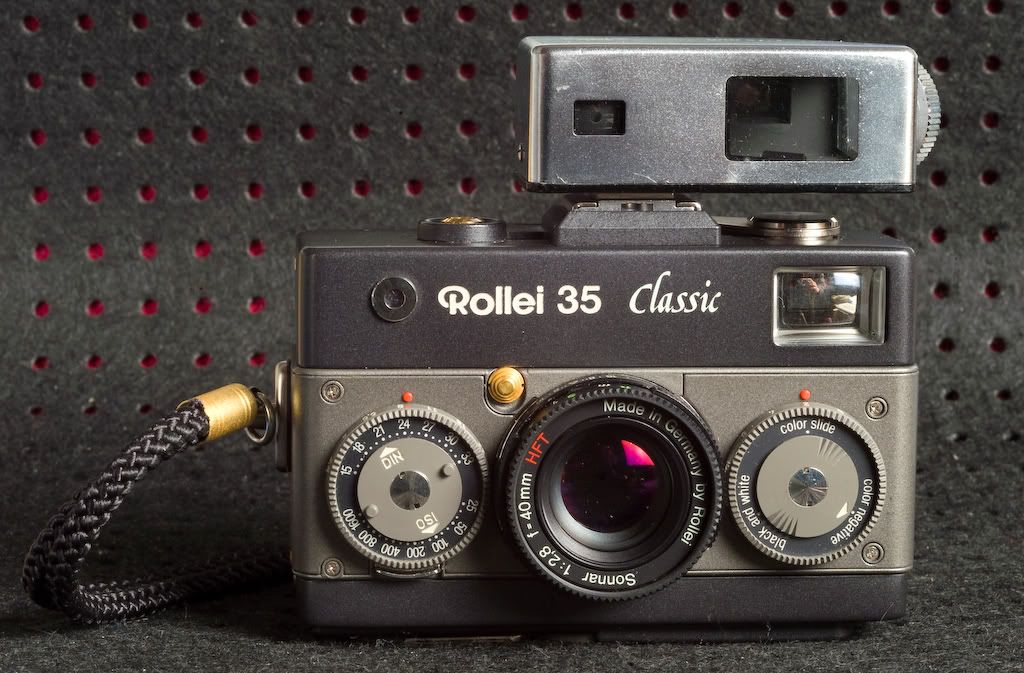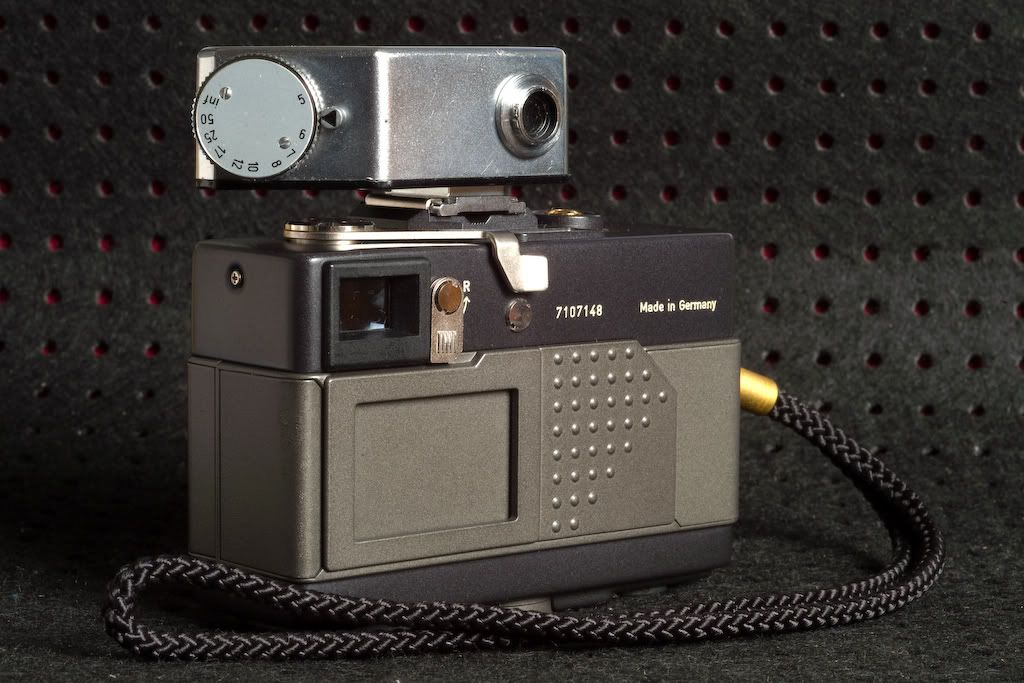amoebahydra
Established
I was given a rollei 35 camera (made in Singapore) for my birthday and I just shot a roll of color film with it.
Though I like the feel of the camera, I don't like the focusing mechanism. There is no parallelex focusing mechanism; you have to guess the distance to your object. This makes the camera impractical for my use, since I like to shoot people, not nature.
Also, I did not think my pictures came out particularly sharp. The camera has a zeiss lens. I took my pictures with a variety of lens openings, from wide open to completely shut down.
Has anyone else had success using this camera?
With cameras without rangefinder, I usually use hyperfocal method. However, I would also attach rangefinder accessory to the accessory shoe making distance measurement and transfer to the focusing ring for exposure.


Chyn
Established
amoebahydra,
Is that a Voigtländer rangefinder? I'm interested in where one can acquire one of these, as I have a Rollei 35s. I've been scale-focusing with great success, but looking for more accuracy.
Is that a Voigtländer rangefinder? I'm interested in where one can acquire one of these, as I have a Rollei 35s. I've been scale-focusing with great success, but looking for more accuracy.
amoebahydra
Established
amoebahydra,
Is that a Voigtländer rangefinder? I'm interested in where one can acquire one of these, as I have a Rollei 35s. I've been scale-focusing with great success, but looking for more accuracy.
No, the one attached is the Zeiss Ikon 426 viewfinder/rangefinder.
I also have the Voigtlander Proximeter rangefinder and Leitz FOKUS rangefinder. The most accurate one is the Leitz rangefinder as it got longest measuring base, but it is more expensive. The accuracy of the other two beyond 20 feet is vulnerable, which however will be covered by depth of field.
I attached a photo of them, from left to right, Leitz, Voigtlander and Zeiss Ikon

Chyn
Established
amoebahydra,
Thanks for posting the image, it makes for a very nice reference.
Thanks for posting the image, it makes for a very nice reference.
John Lawrence
Well-known
I've owned a few Rollei 35s and when first using the camera I found that I was having trouble getting sharp pictures due to my inexperience in estimating the distance. Until I became proficient, I carried and used an accessory rangefinder meter which resulted in sharp pictures.
FallisPhoto
Mentor
you have to guess the distance to your object.
Uh... That's why it is called (improperly) scale focusing (real scale focusing cameras have a scale -- three ranges usually marked portrait, group and landscape). Actually, that is a "ranging" camera (not to be confused with a rangefinder, which it also isn't). Long ago, all cameras used to be like that. You can make your best guess about the distance and use depth of field to compensate for error, or you can measure the distance to the subject, or you can buy an accessory rangefinder (to measure the distance to the subject for you), or you can adjust the lens to the hyperfocal distance (with a small aperture, so pretty much everything is in focus). All four approaches work, and which one you use is up to you.
Last edited:
Jonathan R
Established
There is nothing whatever wrong with the Singapore-made Tessar, except its performance wide open and its lack of contrast (which in old Leica lenses would be turned into a virtue!). Stopped down, it can deliver excellent sharpness.
See these examples, full-frame and detail, hand-held on Delta 100, scanned on a mediochre Epson.
http://gallery.photo.net/photo/8752436-lg.jpg
http://gallery.photo.net/photo/8752435-lg.jpg
I can read this board easily, though admittedly I know what kind of words to expect.
Like others who have replied here, I've had some very nice images made with the Rollei 35 and that lens. I feel it's the smallest amount of decent film camera one can reasonably get away with, but I prefer a Leica for its simple ergonomics, lens performance wide open, and the on-board rangefinder.
See also:
http://gallery.photo.net/photo/4281642-lg.jpg
http://gallery.photo.net/photo/4506776-lg.jpg
The second of these was wide open at 1/15, hand-held. I guessed the focus wrong by about 6 inches. That's what made me buy a Leica!
See these examples, full-frame and detail, hand-held on Delta 100, scanned on a mediochre Epson.
http://gallery.photo.net/photo/8752436-lg.jpg
http://gallery.photo.net/photo/8752435-lg.jpg
I can read this board easily, though admittedly I know what kind of words to expect.
Like others who have replied here, I've had some very nice images made with the Rollei 35 and that lens. I feel it's the smallest amount of decent film camera one can reasonably get away with, but I prefer a Leica for its simple ergonomics, lens performance wide open, and the on-board rangefinder.
See also:
http://gallery.photo.net/photo/4281642-lg.jpg
http://gallery.photo.net/photo/4506776-lg.jpg
The second of these was wide open at 1/15, hand-held. I guessed the focus wrong by about 6 inches. That's what made me buy a Leica!
Jonathan R
Established
Emile de Leon
Well-known
Mine is a good color camera..
B&W..not so much for some reason..
B&W..not so much for some reason..
DwF
Well-known
I love the camera for it's design and feel. I agree that the focusing when not using an accessory rangefinder is tricky. I also have the Voigtlander which slips nicely into the accessory shoe on my 35S. For sure it takes practice to work on closer focusing but the mechanism on the lens should work smoothly. There is a use it or lose it with the Rollei 35 for sure. And not only focus but remembering to advance film before closing the lens back into the body and so on.
This pic below while waiting for espresso was possibly f4, and my estimate of distance for focus was pretty spot-on, surpassed by a really good Zeiss lens!
This pic below while waiting for espresso was possibly f4, and my estimate of distance for focus was pretty spot-on, surpassed by a really good Zeiss lens!
Philip Whiteman
Well-known
My Rollei 35 is one of the last cameras I would ever part with. As regards estimating distance, eye to end of outstretched arm equals around three feet, lay down betrween you and the subject and it's six (if you are my height) and if it's about as far as laying down with an arm outstretched eight feet etc - and it's only the close distances that are critical...
lxmike
M2 fan.
Working with the depth of field scale , coupled with correct exposure setting are key, The Rollei 35 is a camera that you have to put a lot in to, but put the time and effort in and it will give back so much.
Jonathan R
Established
Exactly, Philip, well put. At f/2 one's inaccuracy in distance estimation might be evident, but that's a good reason why the original f/3.5 Tessar was such an appropriate choice, rather than the later f/2 Sonnar. There's a fascinating history of the development of the Rollei35 on the Rollei Club website here.
DwF
Well-known
Exactly, Philip, well put. At f/2 one's inaccuracy in distance estimation might be evident, but that's a good reason why the original f/3.5 Tessar was such an appropriate choice, rather than the later f/2 Sonnar. There's a fascinating history of the development of the Rollei35 on the Rollei Club website here.
The 40mm Sonnar on the 35S is f 2.8 and a different lens than the f3.5 Tessar. I certainly won't get into rendering or which might be better at f3.5 -both excellent cameras.
David
Share:
-
This site uses cookies to help personalise content, tailor your experience and to keep you logged in if you register.
By continuing to use this site, you are consenting to our use of cookies.


